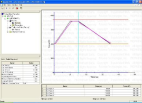Critical to the LED assembly process is a void-free eutectic solder interface between the diode and its substrate - this provides the thermal and electrical connections needed to generate a stable transmission of light. Eutectic die attachments transfer the tremendous amount of heat generated by the diodes to maintain the temperature stability of the device. The vital point to make here is that controlling the eutectic attach process is critical to yield and reliability. The eutectic process is computer controlled and tightly held in order to avoid damage to materials.
Precision eutectic component attach includes pick and place of the diode; in-situ reflow of pre-form or pre-tinned devices with programmable x, y, or z-axis agitation; and programable pulse heating or steady state temperature. To yield the optimal thermally conducting solder interface, the temperature profile of the attachment process must be repeatable and have the capability for a high temperature ramp rate (again, further to the computer controlled aspect stated above). Once the interface is brought up to the proper eutectic temperature, the heating mechanism must maintain that programmed temperature with minimal overshoot.
 After the required amount of reflow time, the heating mechanism must controllably cool (as shown to the left) to minimize damage to the diode and to allow the eutectic material to reach metallurgical equalibrium. This equalibrium is reached through simultaneous application of active thermoelectric pulse heating (via a pulse heat tool) and cooling gases. Palomar's Ultra High Accuracy Die Bonder has this pulse heat pick tool that works in combination with the computer controlled temperature ramp ups and downs.
After the required amount of reflow time, the heating mechanism must controllably cool (as shown to the left) to minimize damage to the diode and to allow the eutectic material to reach metallurgical equalibrium. This equalibrium is reached through simultaneous application of active thermoelectric pulse heating (via a pulse heat tool) and cooling gases. Palomar's Ultra High Accuracy Die Bonder has this pulse heat pick tool that works in combination with the computer controlled temperature ramp ups and downs.
LED matrix assembly is an extremely temperature-sensitive process that requires careful control during assembly. The reflow profile during an in-situ eutectic die attach process is engineered to provide consistent melting and void-free attach interface. This is neccessary for consistent heat transfer from the diode and contributes significantly to temperature stabilization during LED operation.
I'll cite an example where a ganged pulse-heat reflow was used (similar to the screen shot image above). During the pulsed heat cycle, temperatures were ramped from a pre-heat temperature to the reflow temperature using a servo-controlled ramp profile with low overshoot compared to traditional heater stage systems. The reflow temperature is held for a prescribed duration and then the cooling is commanded using both servo-control temperature and cooling gas. Temperature profile repeatability is critical to the process to allow proper eutectic wetting with low voids without damaging the LEDs.
Required temperature profiles depend on the substrate materials, geometry, and solder composition. Programable point-and-click profiling was used for establishing the temperature command profile. The system also captures actual temperature profiles during bonding for process traceability. Pulsed-heat profile control allows batch relfow of the LED matrix for reduced overall cycle time and minimum time at temperature for the protection of temperature sensitive LED devices.
The tight temperature control via eutectic process in combination with the ability to repeat the process accurately provide for robust and scalable LED assembly.